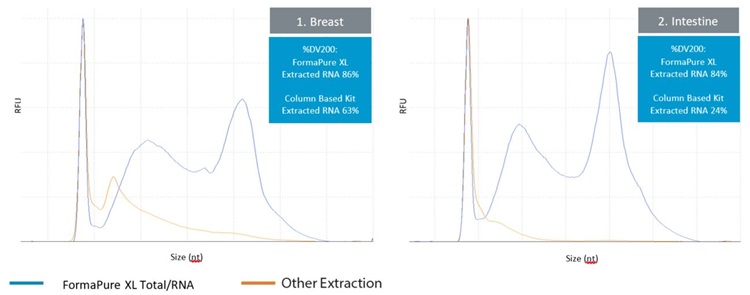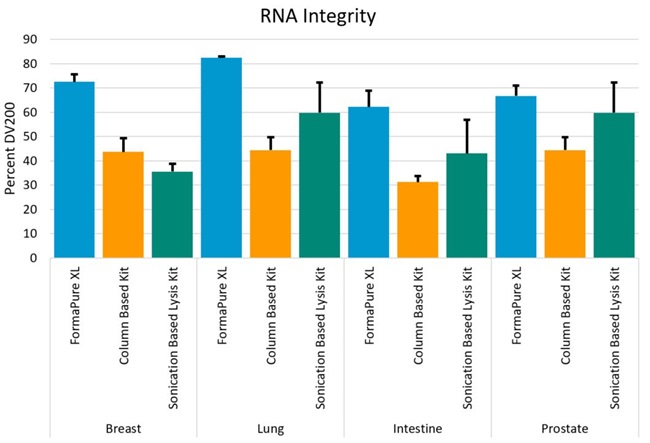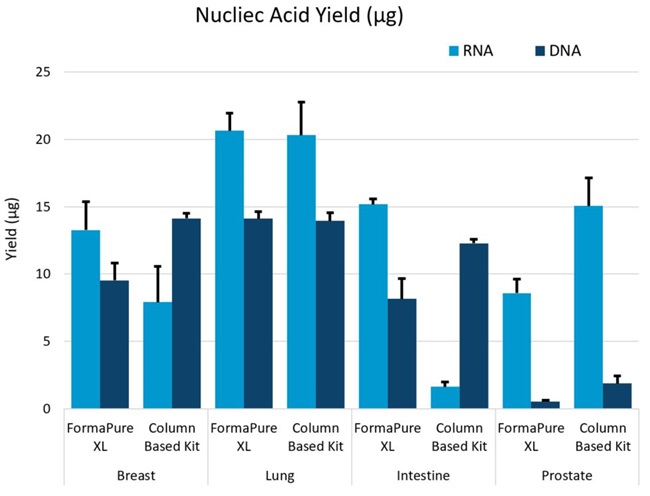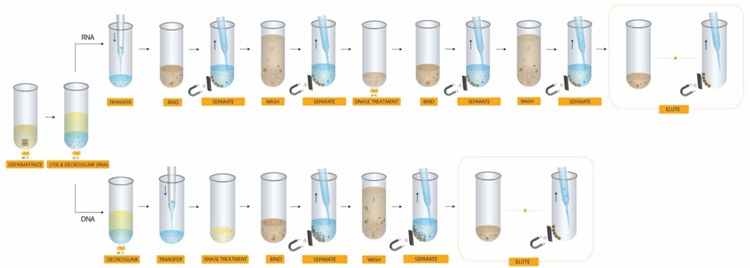FormaPure XL Performance and Data
Manual or Automated RNA, DNA or Total Nucleic Acid Extraction from FFPE Tissues
Nucleic acid extraction from formalin-fixed, paraffin-embedded (FFPE) tissue is challenging due to the nature of the tissue preparation. FormaPure XL reagent kits represent a single chemistry system with demonstrated capability for use in Next-Generation Sequencing (NGS) as well as other downstream applications including qPCR. Maximizing integrity, yield and purity from an FFPE sample is required to minimize the risk of losing important genetic information.
- Data showing consistent extraction of NGS compatible RNA and/or DNA from a single FFPE sample
- Demonstrated flexible single chemistry system for use with 10 µM to 70 µM sample input
- Higher integrity nucleic acids supporting improved sensitivity for qPCR and NGS applications*
NGS Performance Starts with RNA Integrity
Fragment analysis shows FormaPure XL reagent kits extract RNA with higher percent DV200 scores than RNA extracted from the same block using a column based kit. Higher percent DV200s can result in a better performing NGS.

Figure 1 and Figure 2: FormaPure XL Total and FormaPure XL RNA isolates RNA with higher integrity than a column based kit. RNA was evaluated on the Agilent RNA ScreenTape. RNA isolated with FormaPure XL RNA (blue traces) and an alternative column based kit (orange traces) from four different FFPE samples. Extractions from breast and intestine were performed with seven 10 μm. The DV200 values are resented for each of the electropherogram. The percent DV200 values represent the percentage of RNA fragments greater than 200 nucleotides.

Figure 3: FormaPure XL Total and FormaPure XL RNA isolates RNA with equal or higher integrity than both a column based kit and a sonication based lysis kit as evaluated on the Agilent RNA ScreenTape. Extractions were from 1 10 uM curl of breast, intestine, prostate, and lung tissue. The average percent DV200 values are represented for three technical replicates and the error bars are representative of the standard deviation of the three technical replicates.
Nucleic acid yields are determined by the following variables:
Tissue Type; tissue size; tumor type; fixation method; paraffin embedding method; reagents; storage conditions; tissue input amount; extraction chemistry; age of tissue block.

Figure 4: RNA and DNA were isolated using FormaPure XL Total and a column based kit from 5 different FFPE tissue sample types. All extractions were performed with seven 10 μM curls. The average yield from three technical replicates is presented above. Nucleic acid yield was estimated using Quant-it assay (ThermoFisher Scientific).
FormaPure XL can allow a user to extract from their desired amounts of curls. Not every lab will receive the same amount of tissue to extract from. FormaPure XL allows the user to extract from as much or as little tissue that the user can define.
| Number of Curls | RNA Yield (ug) | DNA Yield (ug) |
|---|---|---|
| 1 | 1.0 | 1.2 |
| 3 | 3.5 | 3.1 |
| 5 | 10.3 | 11.3 |
| 7 | 13.3 | 9.5 |
Table 1: RNA and DNA was isolated with FormaPure XL Total from FFPE breast tissue. An increasing number of curls were used. The nucleic acid yield increased with increasing numbers of curls except for DNA extracted from seven 10 μM curls (due to variation in tissue content within curls).
Visual Workflow

- Deparaffinize FFPE tissue
- Lyse FFPE tissue and decrosslink RNA
- Transfer half of the lysate for RNA workflow
- Bind RNA to magnetic beads
- Separate magnetic beads from contaminants
- Wash magnetic beads with 80% ethanol to remove contaminants
- Treat samples with DNase I
- Rebind RNA to magnetic beads with RBA
- Separate magnetic beads from contaminants
- Wash magnetic beads with 70% ethanol to remove contaminants
- Elute RNA from magnetic beads
- Process remaining lysate for DNA workflow
- Decrosslink DNA
- Transfer remaining lysate for DNA workflow
- Treat samples with RNase A
- Bind DNA to magnetic beads
- Separate magnetic beads from contaminants
- Wash magnetic beads with 80% ethanol to remove contaminants
- Elute DNA from magnetic beads
- Transfer eluted RNA and DNA to a storage plate
Automation Method vs. Manual Timing
FormaPure XL Total, RNA and DNA are a flexible set of extraction kits suitable for manual or automated workflows.
- Scalable based on throughput
- Quick transition with ready-to-implement methods
- Knowledgeable support for reagents, automation and methods from a single vendor
| FormaPure XL Total | FormaPure XL DNA | FormaPure XL RNA | ||||||
|---|---|---|---|---|---|---|---|---|
| Manual | Automated | Manual | Automated | Manual | Automated | |||
| Batch Size | 8 | Hands-on Time | 3.5 | 0.5 | 1 | 0.5 | 2 | 0.5 |
| Total Time | 6.5 | 6 | 3.5 | 5.25 | 4.5 | 5 | ||
| 24 | Hands-on Time | 4 | 0.5 | 1.5 | 0.5 | 2.5 | 0.5 | |
| Total Time | 7 | 6.25 | 4 | 5.5 | 5 | 5 | ||
| 48 | Hands-on Time | NR | 0.5 | NR | 0.5 | NR | 0.5 | |
| Total Time | NR | 6.5 | NR | 5.5 | NR | 5.5 | ||
| 96 | Hands-on Time | NR | 0.5 | NR | 0.5 | NR | 0.5 | |
| Total Time | NR | 6.75 | NR | 5.75 | NR | 5.5 | ||
Table 2: Estimated hands-on-time and total time in hours, required to perform 8, 24, 48 and 96 FormaPure XL Total, RNA or DNA nucleic acid extractions. The methods can be performed either manually or automated on a liquid handling system. Data represented in this table is based on a Biomek i7 Hybrid. The difference in time between manual and automation is indicated. NR=Not recommended.
FormaPure XL Products for RNA, DNA and Total Nucleic Acid Isolation from FFPE Tissue
FormaPure reagent kits are available in multiple kit sizes and extraction types based on your application and throughput needs. Contact us today by filling out the form on this page for your quote.
| Part Number | Name | Preps |
|---|---|---|
| C35991 | FormaPure XL Total | 50 |
| C35992 | FormaPure XL Total | 96 |
| Part Number | Name | Preps |
| C35996 | FormaPure XL DNA | 50 |
| C35997 | FormaPure XL DNA | 96 |
| Part Number | Name | Preps |
| C36000 | FormaPure XL RNA | 50 |
| C36001 | FormaPure XL RNA | 96 |

